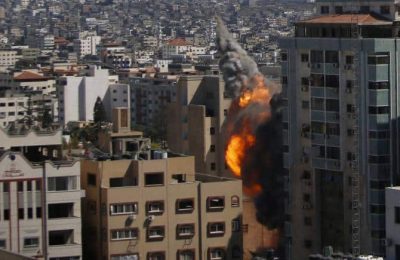Gaza: The Epicentre of Resistance

All Global Research articles can be read in 51 languages by activating the “Translate Website” drop down menu on the top banner of our home page (Desktop version).
Visit and follow us on Instagram at @crg_globalresearch.
***
Once again the international community is faced with the problem of rebuilding Gaza after an 11-day bout of bombings and rocket exchanges which have left 248 Palestinians dead,1,900 wounded, and reduced to rubble the strip’s infrastructure and commercial and residential buildings. The UN is calling for billions of dollars to pay for reconstruction. Following the devastating 59-day 2014 Israeli assault on Gaza, the UN appealed for $5.4 billion but received only about half, leaving large areas of the strip partially reconstructed.
The Biden administration has promised aid but has been tight-fisted when reverting to Donald Trump’s cancelled funding for UNRWA, the agency providing for 5 million Palestinian refugees, and projects in East Jerusalem, the West Bank and Gaza. Josip Borrell, the high representative of the European Union, the largest donor to Palestinian relief, has expressed exasperation over the failure of world leaders to address the causes of the conflict which produces round after round of violence and destruction in Gaza. However, as Israel’s main trading partner, the EU would be in a strong position to sanction Israel over its disproportionately devasting assaults on Gaza.
The UN estimates that at least 77,000 Palestinians have been rendered homeless by Israeli air strikes that collapsed scores of apartment blocks, damaged others, and destroyed roads. Half a dozen hospitals, the COVID-19 testing centre, and 11 clinics were damaged, electricity lines were brought down, and nearly half of Gaza’s two million inhabitants lack potable water because desalination plants cannot function without power. Gaza’s aquifers have long been polluted by sea water,sewage and agricultural run-off.
Fabrizio Cabroni, regional director for the International Committee of the Red Cross, predicted that the damage inflicted in the 11 days of Israeli bombing and shelling “will take years if not decades to rebuild”.
This is the case because Israel is unlikely to lift its siege and blockade of Gaza to allow cement and other construction materials into the strip. Following the devastation wreaked by Israel in 2008-09 and 2014, Israel, which controls the sole goods crossing into Gaza, permitted only UN and a few other humanitarian agencies to import essential reconstruction material into the strip and imposed bureaucratic procedures which complicated and delayed shipments. The pretext Israel gives for this policy is that it does not want to provide Hamas with material to renew its arsenal of rockets.
Reconstruction after the 2008-09 Israeli onslaught proceeded more quickly than in the 2012 and 2014 attacks because Gazans were able to import cement, fuel and other essentials as well as consumer goods through the 1,500 smuggling tunnels between Rafah, in the south of the strip and Egypt. However, Egypt destroyed the tunnels between 2011-13, after the Arab Spring uprisings. This harmed both the people of Gaza and the North Sinai bedouin who depended on the smuggling business and may have contributed to their protracted armed revolt against Cairo.
The tunnels gave Gaza partial normalcy. I visited a tunnel for goods and another bringing fuel. Since they were destroyed, Gazans have been totally dependent on Israel, which operates the sole goods crossing, for imports and intermittently reliant on Egypt for an Arab exit from the besieged and blockaded strip. For a decade, Gazans have been trapped and subjected to the whims and political calculations of Israel’s increasingly right-wing leaders and an Egyptian government determined to prevent or bring to an end to explosions in Gaza.
Although the “two state solution” involving the emergence of a Palestinian state alongside Israel remains, theoretically, on the international agenda, Israel has done its utmost to prevent this from becoming reality by planting colonies throughout the West Bank and East Jerusalem and cultivating division between Hamas-ruled Gaza and the Fateh-administered West Bank. This division dissolved temporarily during the May onslaught on Gaza as did the separation between Palestinian citizens of Israel and stateless Palestinians in the 1967 occupied territories. Since Palestinian unity was the last thing Israel thought would emerge during this bout of violence, Palestinians must do their utmost to sustain it.
In the absence of the “two-state solution”, there must be new thinking on how to achieve a modicum of development and comfort for all Palestinians living in the land between the Mediterranean and the Jordan River and Gaza, in particular.
UNRWA head Philippe Lazzarini said reconstruction in Gaza has to proceed along with efforts to create “a different sort of political environment” focusing on proper access to education, jobs and livelihoods. This is essential but cannot be achieved unless Israel lifts the siege and blockade of the strip and its 2 million inhabitants. This should be the first and foremost objective of the powers who have influence with Israel, notably the US and Western European countries.
Although Israel argues that isolating Gaza prevents Hamas from importing weaponry and the means to mount attacks on Israel, all the eruptions of violence since 2008 have shown that Hamas is able to obtain the material to manufacture crude rockets as well as secure other weapons while Gaza has been under Israeli control from land, sea and air. Therefore, the siege and blockade are pointless from this perspective and only punish the population — which is what Israel aims to do because, since Israel’s creation in 1948, Gaza has been the epicentre of resistance. It is all too clear that this policy has been counterproductive and should be abandoned.
*
Note to readers: Please click the share buttons above or below. Follow us on Instagram, @crg_globalresearch. Forward this article to your email lists. Crosspost on your blog site, internet forums. etc.
Featured image: Building housing the offices of Associated Press and other media collapses after Israeli airstrike, Gaza City, May 15, 2021. (Source: Indian Punchline)

